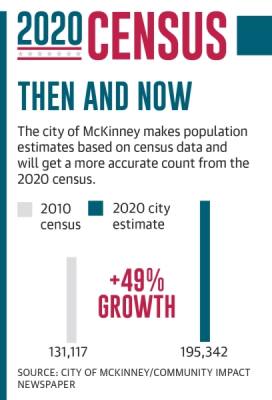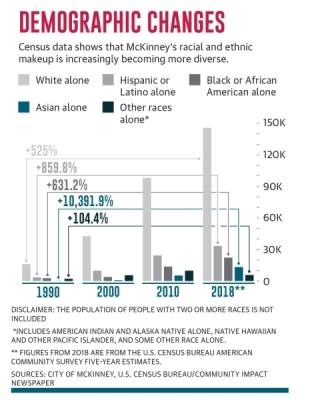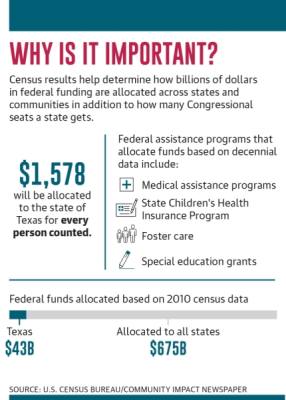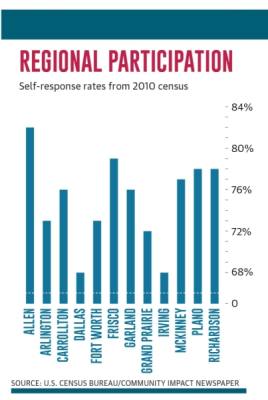Every 10 years since 1790, the U.S. Census Bureau has counted the number of people living in the country. Census results help determine how billions of dollars in federal funding are distributed across states and communities. They also determine the boundaries for City Council districts as well as areas of representation by state and federal lawmakers.
In 2010, McKinney saw a 77% self-response rate, according to the bureau. The city’s population has grown by roughly 64,000 people since then, which makes it especially important to get a more accurate count this census year, according to city officials.
“One of the major challenges is reminding everyone that it is important to be counted in Census 2020,” said Shirletta Best, community services administrator for the city of McKinney.
Additional efforts are underway this year to ensure McKinney’s population is properly documented.
The city of McKinney provided $50,000 for local census efforts, Best said, and in November 2019, the city and Collin County Business Alliance partnered with the U.S. Census Bureau to form complete count committees.
These groups are made up of representatives from every facet of city life who have been strategizing to determine how to increase awareness, mobilization and participation.
“People are busy and living their daily lives, but it is so important,” Best said in an email. “We must rely on each other: trusted community leaders, neighbors, friends, teachers, health care providers, faith leaders—everyone who is invested in McKinney. This is the time to participate and be counted.”
Why a complete count matters
The city relies heavily on federal funds to support its growing citizenry. Each year, federal agencies rely on census data when distributing nearly $675 billion to states, counties and municipalities. At the city level, an inaccurate count could lead to less federal funding to support services, such as transportation and public education.
Because of its size, Texas is the third-largest recipient of federal funding allocated through census data, according to the Texas Demographic Center.
An undercount of the state’s population by just 1% could result in a $300 million loss in federal funds, according to the center.
“That is the importance of making sure that every single person in our state, whether they’re here legally or not, are counted because they are here, and every person who is here is using resources,” said Lisa Hermes, McKinney Chamber of Commerce president and CEO. “And if we’re not able to count all the people who are here, we’re not able to plan for the resources that are necessary.”
Census data is also used to determine the number of congressional seats and the electoral college votes each state has. This is especially important, as early estimates project Texas’ population growth could lead to an additional two or three seats in the U.S. House of Representatives, according to city officials.
'Hard-to-count’
Certain sociodemographic groups are at higher risk of being undercounted, according to the bureau.
“We know that each time we have a census, there is an undercount,” Best said. “There are vulnerable populations that we know for certain that are hard to count or that could be undercounted. That includes our veterans; that includes our seniors; it includes the homeless. But most importantly, it also includes our children.”
Parents tend to count themselves, but not their children, she said.
“As a result, we will lose population counts that will impact our schools, [and] that will impact the city as a whole,” Best said.
For its part, McKinney ISD will feature a “Let’s Make McKinney Count!” message during stadium events to remind residents to complete the census forms.
In that video, McKinney ISD Superintendent Rick McDaniel highlights some of the community assets that are financed by federal funds that depend on census results.
“This money is used to help build our schools, our fire departments and hospitals in our community. It helps build roads and housing, too,” McDaniel said in the video.
Participating MISD schools will share their own video with elementary students in English and Spanish, Best said. Participating middle schools will use the “Census in the Schools” curriculum during census week, which runs from March 28-April 3.
Census workers said renters, college students, families who move frequently and people with mental or physical disabilities are also difficult to count.
The lowest participation rates in McKinney in the past were east of SH 5, where the city’s largest population of non-English speakers lives, according to the bureau.
This population tends to face language barriers, live in multigenerational housing or harbor suspicion over how census data is used, all of which puts them at risk of being undercounted, according to the bureau.
Due to the negative rhetoric surrounding immigration, many immigrant households may be reluctant to participate, officials said.
Best said it is important to note that there is no citizenship question on the census.
In addition, information gathered is not analyzed individually but is instead used to create statistics for the area as a whole.
“By law, information is kept confidential, and answers to the census questionnaire cannot be used against a person or persons by any government agency,” Best said in an email.
District boundaries
Once McKinney receives the census results in 2021, city staff will begin analyzing how City Council district boundaries should shift.
Single-member districts were first created in McKinney in 1977 through a charter election. They were aimed at ensuring minority representation was not diluted, City Attorney Mark Houser said in an email. District boundary lines have been redrawn after each census year since then.
“The districts are derived from a complex analysis of voter ethnicity, demographics and population in an effort to give each voter an equal effect on electing a council member to the respective districts,” Houser said in the email.
The current boundaries were drawn in 2011 to include roughly 35,000 people in each district, according to Houser. District 1, where less than 50% of residents were white in 2011, was identified as a minority-majority district at that time.
The most recent population estimates suggest districts will be redrawn to include about 49,000 residents. The census results will also show whether that minority majority still exists in District 1, Houser said.
“From growth patterns, we could have disparate increases in the northern and western parts of the city,” Houser said in the email.









